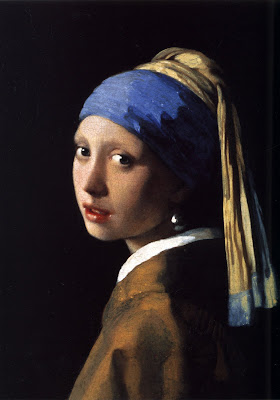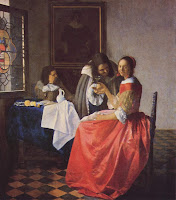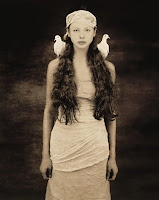 According to the Wikipedia entry, Johannes (Jan) Vermeer was, “a Dutch Baroque painter who specialized in exquisite, domestic interior scenes of middle class life.” Unlike the other painters featured in the “Painters Every Photographer Should Know” series, Vermeer is a bit of a mystery-little is known about his personal life and his techniques are widely speculated about but not totally understood.
According to the Wikipedia entry, Johannes (Jan) Vermeer was, “a Dutch Baroque painter who specialized in exquisite, domestic interior scenes of middle class life.” Unlike the other painters featured in the “Painters Every Photographer Should Know” series, Vermeer is a bit of a mystery-little is known about his personal life and his techniques are widely speculated about but not totally understood.
Some facts do exist-he was born and lived his entire life in the city of Delft. His father, Reijnier, was a middle-class tradesman who first worked with textiles-silk and caffa (a patterned silk fabric,) then later became an inn keeper. After his father’s death, Vermeer replaced him as a merchant of paintings. Though not Catholic himself, he married a Catholic girl named Catherina Bolnes, who was from a wealthy family. Vermeer fathered 14 children, 10 of whom survived. He was not a prolific painter, and produced only a few works as compared to some of his counterparts.
Camera Obscura
Since little is known about how Vermeer studied and learned his craft, nor did he have any pupils from which to gleam information, there is much speculation surrounding his technique, but few solid facts. David Hockney and other art historians have speculated that Vermeer used a camera obscura (an optical device used as a projector, the precursor to the modern day camera) as an aid in his compositions. There is no concrete evidence to support this and very little is actually known about Vermeer’s technique, thanks in part to the nature of painting techniques from that time. Paintings were done typically over a base layer or drawing, which was traditionally done using charcoal, chalk, or the like. This base layer served as an underdrawing. Since the original drawing was essentially covered up as subsequent layers of paint were applied, it left little evidence behind as to what it might have looked like before the paint layers were painted on. No Vermeer drawings have survived, adding more fuel to the fires of speculation over his work.
Some facts that  are known-Vermeer favored expensive pigments in his painting and had, quite literally, a “rich” color palette-featuring shades like lapis lazuli, ultramarine, and also various shades of umber and ochre to represent warm light. Vermeer also used a technique known as underpainting-in his work “The Girl with a Wine Glass” for example, the shadows of the girl’s red satin dress are underpainted in natural ultramarine, which gives the dress a crisp, slightly purple look.
are known-Vermeer favored expensive pigments in his painting and had, quite literally, a “rich” color palette-featuring shades like lapis lazuli, ultramarine, and also various shades of umber and ochre to represent warm light. Vermeer also used a technique known as underpainting-in his work “The Girl with a Wine Glass” for example, the shadows of the girl’s red satin dress are underpainted in natural ultramarine, which gives the dress a crisp, slightly purple look.
What Photographers Can Learn From Him
A Vermeer work shouts in soft shadows. His interiors feature careful reflections and impeccable portrait lighting. Vermeer produced elegant studies with careful light. He had a subtle layered palette that photographers can reproduce with careful lighting techniques. Look at Joyce Tenneson’s work, for example, to see how this might come into a more photographic medium.
Most photographers understand how critical lighting is to a strong image, after all photography is all about light, but it’s not just the amount of light, it’s the quality of the light and the mood that the light sets as it reflects and refracts off surrounding surfaces. According to the wiki, “he created a world more perfect than any he had witnessed. This working method most probably was inspired by Vermeer’s understanding of Leonardo’s observations that the surface of every object partakes of the colour of the adjacent object. This means that no object is ever seen entirely in its natural colour.” A Vermeer painting is a quiet study of light and shadow-warm into cool, soft, subtle, pensively reflective, elegant tones with detailed shadows mark his work. Vermeer is all about lyrical light-the interplay of light and shadow almost sings in his work. For a photographer, mastering the quality of light and creating depth from lighting techniques can really create a compelling portrait or interior scene.
For his lyrical light, his skill at layering and rich color palette, his careful reflections and elegant interior studies, the exquisite subtlety of Jan Vermeer earns him a spot in the ranks of “Painters Every Photographer Should Know.” You can read more about Vermeer on the Wikipedia entry about him or stop to visit Essential Vermeer.com, and look for more posts (and painters) as part of the series.
—————————————————————————————————————
This is next in a series called “Painters Every Photographer Should Know.” The paintings shown here are Vermeer’s “Girl with a Pearl Earring” (circa 1665) and “The Girl with a Wine Glass” (circa 1659). Joyce Tenneson’s Dasha, Russia work is also shown. Please note that the paintings and photographs in this series are not copyright the author of this website, may be subject to international copyright law, and are provided her for educational purposes only.


Author
The film, 'Girl With A Pearl Earring', a piece of hisorical fiction about Vermeer is worth a watch. Especially, if you are a Scarlett Johannson, as I am!!!
Author
You know, Mythopolis, I heard that movie was good but I was afraid to watch it. The painting is one of my favorites but I was afraid the movie might ruin it for me. Now, I might have to check it out, thanks!
Author
Can't vouch for historical accuracy…but yes, a good watch!
Author
My daughter studied Vermeer in school this year…nice post!